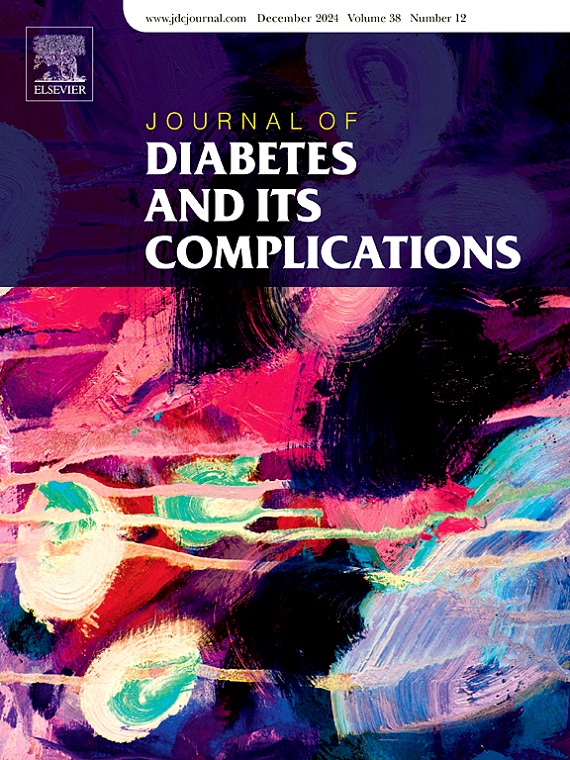Burden and progression of arterial calcification in type 1 diabetes predicts future cardiovascular disease
IF 3.1
3区 医学
Q3 ENDOCRINOLOGY & METABOLISM
引用次数: 0
Abstract
Aims
Even in the absence of kidney disease in persons with type 1 diabetes, there is an increased risk of cardiovascular (CV) disease through mechanisms not fully understood. This study aims to investigate whether evaluating arterial calcification can augment CV risk stratification in people with type 1 diabetes.
Methods
Persons with type 1 diabetes included in previous studies evaluating subclinical CV disease with CT scans of arterial beds in 75 persons without kidney disease were assessed for major adverse CV events (MACE) defined as CV-death, ischemic heart disease, heart failure, stroke, coronary interventions, and/or peripheral artery intervention. CT allowed for evaluation of coronary artery calcium score (CACS), progression of coronary artery calcium and generalised arterial calcification in multiple arterial beds. Cox regression was used for survival analyses.
Results
Seventy-three persons were available for endpoint evaluation and 16 (22 %) experienced a MACE after a median follow-up of 12.4 years (IQR 9.1–12.8). In unadjusted analyses, MACE was associated with baseline CACS > 10 (p = 0.003), progression of coronary artery calcium (p = 0.03) and generalised arterial calcification (p = 0.006). After adjustment for diabetes duration, baseline CACS > 10 remained associated with increased risk of MACE (p = 0.04).
Conclusions
This study shows that increased CACS entails increased risk of future MACE in persons with type 1 diabetes without kidney- or prior CV disease. This finding suggests that CACS evaluation may help differentiate CV risk management in persons with long-term type 1 diabetes without evidence of kidney disease and thus may be another step towards individualised medicine.
1型糖尿病患者动脉钙化的负担和进展预测未来心血管疾病
在1型糖尿病患者没有肾脏疾病的情况下,其发生心血管(CV)疾病的风险增加,其机制尚不完全清楚。本研究旨在探讨评估动脉钙化是否可以增加1型糖尿病患者的心血管风险分层。方法纳入先前研究的1型糖尿病患者,通过动脉床CT扫描评估75名无肾脏疾病患者的亚临床CV疾病,评估主要不良CV事件(MACE),定义为CV-死亡、缺血性心脏病、心力衰竭、中风、冠状动脉干预和/或外周动脉干预。CT可以评估冠状动脉钙化评分(CACS),冠状动脉钙化进展和多动脉床的广泛性动脉钙化。采用Cox回归进行生存分析。结果73人可用于终点评估,16人(22%)在中位随访12.4年(IQR 9.1-12.8)后经历了MACE。在未经调整的分析中,MACE与基线CACS >; 10 (p = 0.003)、冠状动脉钙化进展(p = 0.03)和广泛性动脉钙化(p = 0.006)相关。调整糖尿病持续时间后,基线CACS >; 10仍与MACE风险增加相关(p = 0.04)。结论:本研究表明,无肾脏或既往CV疾病的1型糖尿病患者,CACS升高会增加未来MACE的风险。这一发现表明,CACS评估可能有助于区分无肾脏疾病证据的长期1型糖尿病患者的CV风险管理,因此可能是个体化治疗的又一步。
本文章由计算机程序翻译,如有差异,请以英文原文为准。
求助全文
约1分钟内获得全文
求助全文
来源期刊

Journal of diabetes and its complications
医学-内分泌学与代谢
CiteScore
5.90
自引率
3.30%
发文量
153
审稿时长
16 days
期刊介绍:
Journal of Diabetes and Its Complications (JDC) is a journal for health care practitioners and researchers, that publishes original research about the pathogenesis, diagnosis and management of diabetes mellitus and its complications. JDC also publishes articles on physiological and molecular aspects of glucose homeostasis.
The primary purpose of JDC is to act as a source of information usable by diabetes practitioners and researchers to increase their knowledge about mechanisms of diabetes and complications development, and promote better management of people with diabetes who are at risk for those complications.
Manuscripts submitted to JDC can report any aspect of basic, translational or clinical research as well as epidemiology. Topics can range broadly from early prediabetes to late-stage complicated diabetes. Topics relevant to basic/translational reports include pancreatic islet dysfunction and insulin resistance, altered adipose tissue function in diabetes, altered neuronal control of glucose homeostasis and mechanisms of drug action. Topics relevant to diabetic complications include diabetic retinopathy, neuropathy and nephropathy; peripheral vascular disease and coronary heart disease; gastrointestinal disorders, renal failure and impotence; and hypertension and hyperlipidemia.
 求助内容:
求助内容: 应助结果提醒方式:
应助结果提醒方式:


